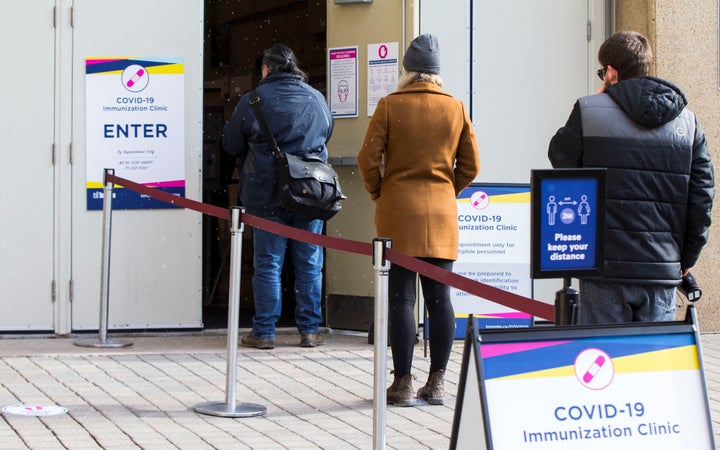One of my patients works in an emergency room at a local hospital. Like many other doctors, nurses, nurse practitioners, personal support workers and other “front-line heroes” in medicine, she has not yet received the COVID-19 vaccine and does not know when she will. Like other hospitals, hers used a lottery to decide who would receive the vaccine and she drew the short straw.
I am a family doctor in Ottawa. As a primary care provider without a hospital affiliation, there’s no vaccine lottery for me. Indeed, very few of us who work outside a hospital setting — face-to-face with patients on a daily basis — will have access to the vaccine until some time next spring. It all comes down to who is and who isn’t a health-care worker, according to our governments — a clear definition that has yet to exist. This affects not only who will get the vaccine and when, but also who will be permitted to administer the vaccine to your community.

Many provinces and territories are currently in the first stages of COVID vaccine distribution, which means prioritizing vulnerable populations and the people who care for them — health-care workers in hospitals, long-term care (LTC) homes, retirement homes, other congregate care settings and remote Indigenous communities. (Here in Ontario, reaching these priority groups is significantly complicated by the provincial vaccine task force’s lack of voices from public health or primary care.)
It wasn’t long before the first vaccine selfies hit social media, raising eyebrows as non-patient-facing and board-room staff at hospitals received their shots. CEOs and non-clinical researchers were rolling up their sleeves, while doctors, nurses and paramedics were told that they would have to wait. Some specialties in some hospitals were put on the high-priority list, while others weren’t. In Ontario, vaccines were sent to urban locations as rural hospitals wait. Paramedics had to fight to be amongst the first wave of recipients of the vaccine in Ontario.
The politics of medical hierarchies — geographic bickering, fighting amongst specialists — are not unique to the pandemic. In primary care, we didn’t receive PPE when the pandemic began (although hospitals did) and have yet to be invited to the COVID decision-making table. It sends family doctors a very strong message: “We don’t see you as important to health care.”
“This suggests a piecemeal process, not a provincial strategy.”
While we argue about who has jurisdiction or the mandate to create immunization plans, seniors are dying in long-term care, essential workers are burning out, people in our communities are suffering. At the current rate of immunization, it could take until 2026 to reach the target of immunizing 80 per cent of adults.
These realities spurred the “ready to vaccinate” movement in January 2021, pushing for hospitals and provincial leaders to include community physicians, nurses, pharmacists and others across Canada in the vaccine delivery plan.
I contacted my local hospital and asked how I could participate in vaccination teams going to LTC and retirement homes. I was turned away. A few hundred family doctors in Ottawa similarly offered to help, as well as more than 2,000 family doctors across Ontario. But we were told that the hospital wanted to “keep it to themselves,” in our city, whereas in other regions hospitals chose to include primary care in the vaccine strategy. Public health units admit that there’s still no community distribution plan.
This suggests a piecemeal process, not a provincial strategy. In January 2021, we were reassured that we can expect delivery of 4 million doses of the Pfizer vaccine by the end of March, but I find it hard to believe that we can be on track with primary care almost entirely excluded from planning and delivery. To address this, an Ontario Primary Care COVID-19 Vaccination Action Council was cobbled together by a network of brilliant health-care advocates, attempting to connect a raft of stakeholders. This initiative is great, but it is disheartening that these organizations were forced to take matters into their own hands after being excluded from official provincial strategies.

Hard to imagine that things could get worse. But they will. In Phase 2, the rest of the “health-care workers” who weren’t considered a priority are supposed to be immunized. One issue is that “health-care workers” are not defined in the COVID-19 vaccine diagrams in Ontario, and there is no centralized system to keep track of them across each province.
So, when the time comes, I will get in line with other primary care doctors, nurses, emergency room physicians, and everyone else who defines themselves as a health-care worker: dentists, optometrists, X-ray technicians, midwives, physiotherapists, psychologists, podiatrists, chiropractors, massage therapists, social workers and clinic sanitation crews. There’s no question that they should be vaccinated, or that the office administrators, clerical staff, cleaners and medical equipment reprocessors who ensure our health-care system functions should be, too. And we all need our children’s teachers and daycare staff to be safe. The question is, should they receive the vaccine before the ER doctor or paramedic charged with doing CPR on a child, or intubating a grandmother? As far as I can tell, there is no plan for how this decision will be made.
We need transparency. The lack of plan for Phase 2’s rollout, and the inevitable patchwork of top-down plans that follow, could lead to an inequitable, unnecessarily tense and slow process of protecting health-care workers. Acknowledging that, it is necessary to put pressure on our provincial leaders to engage with our public health units, with primary care and other community-based providers, across Canada, to develop collaborative plans. Health-care workers should not be forced to fight and elbow each other to the front of the vaccine line.
My patients are all shocked to learn that family doctors have yet to be immunized. They shake their heads when I explain to them that there is no plan for immunizing my 93-year-old patient who lives in a retirement home, let alone doctors who work in pediatric emergency rooms, doctors and nurse practitioners in community offices, palliative care specialists, inner-city health workers. We need to be immunized — your health-care workforce — so that we don’t get sick before we are able to hit the streets to immunize the rest of Canada.
Also on HuffPost: